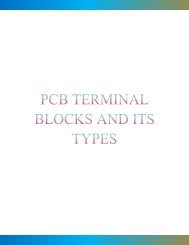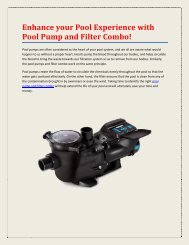PCB TERMINAL BLOCKS AND ITS TYPES
You also want an ePaper? Increase the reach of your titles
YUMPU automatically turns print PDFs into web optimized ePapers that Google loves.
<strong>PCB</strong> terminal block is a modular, insulated device which mounts on Printed<br />
Circuit Board (<strong>PCB</strong>s) to secure two or more wires together. These terminal<br />
blocks consist of various individual terminals that are arranged in a long<br />
strip. They are useful for connecting wiring to the ground, and in the case<br />
of electrical power, used for connecting electrical outlets and switches to<br />
mains.<br />
The terminal body typically consists of a copper alloy having the same<br />
expansion coefficient as the wire which is intended to use. This not only<br />
prevents loosening but also reduces the corrosion caused by an<br />
electrolytic action between two metals. These terminal blocks are also<br />
known as electronic blocks.
Types- <strong>PCB</strong> terminal blocks can be classified into structure and device type<br />
Structure<br />
Types<br />
Device<br />
Types<br />
Dual<br />
Level<br />
Single feed Through<br />
Three Level<br />
Ground Circuit<br />
Terminals<br />
Thermocouple<br />
Blocks<br />
Sensor/actuat<br />
or Blocks<br />
Fuse<br />
Holder<br />
I/O<br />
Blocks<br />
Disconne<br />
ct Blocks<br />
Power<br />
Distribution<br />
Blocks
Single<br />
feed<br />
Through<br />
A single feed product represents a basic<br />
type of terminal block. They are used for<br />
the wire to wire connections. They consist<br />
of one input and one input contact. Two<br />
different wires are inserted into each side<br />
of the terminal block and are connected<br />
within its housing.<br />
Structure Types<br />
Dual<br />
Level<br />
These terminal blocks have two levels of<br />
contact. This type of arrangement saves<br />
space and simplifies wiring. A multilevel<br />
product can use a bridge to connect one<br />
contact level to the other; this increases<br />
circuit flexibility.<br />
Three<br />
Level<br />
These levels of terminal blocks are<br />
similar to dual level products with an<br />
extra added level of contact. Just like<br />
dual level terminal blocks, even these<br />
blocks can be bridged.
Ground<br />
Circuit<br />
Terminal<br />
s<br />
They are used for grounding<br />
components and systems. They can<br />
be interchanged with the standard<br />
terminal blocks and can also be<br />
inserted into a block as and when<br />
needed.<br />
Device Types<br />
Thermo<br />
couple<br />
Blocks<br />
Fuse<br />
Holder<br />
They are typically used to connect<br />
thermocouples and to provide<br />
consistent metal connections in<br />
order to measure the temperature.<br />
They connect various fuses<br />
associated with numerous devices.<br />
Because of this, whenever a short<br />
circuit occurs, only the wiring section<br />
connected to the fuse holder is<br />
affected.<br />
Sensor/<br />
Actuato<br />
r Blocks<br />
They handle three to four devices,<br />
such as photoelectric sensors and<br />
proximity sensors.
I/O<br />
Blocks<br />
They provide communication<br />
between the device and a controller.<br />
Device Types<br />
Power<br />
Distribu<br />
tion<br />
Blocks<br />
They are used to terminate power<br />
cables.<br />
Disconn<br />
ect<br />
Blocks<br />
With the help of knife switch, it<br />
allows a circuit to easily disconnect<br />
without removing wires.

















